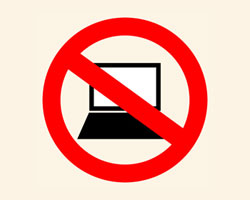
Here is a strange idea: reduce the use of computers in the workplace.
Huhh?!?…
Bear with me and read on…
Computers and Stress
Back in the nineties management at my Intel campus realized that non-stop computer use was causing health damage in the form of RSI (repetitive stress injuries – remember all those weird wrist bandages?). To address it, we implemented structured “stretching sessions” where everyone stopped typing and came together to do directed exercises with music and fun.
Today we see that non-stop computer use is causing health damage in other forms – and it may be time to do something about it.
Prof. Gloria Mark of the University of California at Irvine, one of the leading researchers of computer mediated communications and information overload, spoke at the Overloaded 2014 conference about a study she’d run where knowledge workers’ heart rates were actually monitored for physical stress while using and not using computers. The data showed a clear correlation: computer use (notably email) increases stress. So:
Computers = Stress
From which it follows that:
Less Computers = Less Stress
Stress, it is no secret, is not good for your health. So, here is a corollary:
Less Computers = Healthier employees
We do want employees to be healthy, so – should we reduce computer use? And how could we even do that?
How we can reduce computer use in the workplace
Obviously, we can’t eliminate computers from the workplace. These marvels of technology are so ingrained in our work life (and life in general)) that we no longer even marvel at them; we take them for granted, and every facet of our jobs in deeply integrated with them. So what is the point?
My point is this: we can reduce stress and its many ill effects by building some computer-free time into our daily routines; essentially reintroduce some of the “old ways” of pre-1980 work. I don’t mean doing it by haphazardly taking breaks; I mean by intentionally designing-in some work process elements that circumvent computer usage. For example:
- Forbid email reading and other non-essential computer use at meetings, to encourage involvement and eye contact.
- Intentionally support reading of paper publications, rather than do all our reading on screen. A workplace could do this by keeping a library (“learning center”, in today’s parlance) that intentionally provides paper copies of the main professional journals and daily papers. Reading a paper hardcopy is a very different experience: not only calmer but also devoid of interruptions.
- Hold off-site work group events where people interact without computers.
- Regulate access to email during and after work hours.
- Anything else that will cause people, in a structured manner, to have parts of their workday that allow them to do useful work without computers.
How you can reduce computer use individually
Until your workplace does any of this, you can also take action personally – certainly if you’re a freelance worker like I am today, but also as a salaried employee. It may take more self-control than you like, but you have enough leeway to implement some ideas like taking reading breaks, applying email-free time slots, and balancing work and life.
Your health may depend on it!


Good suggestions Nathan.
I just read this… on a computer. If I acted on your suggestion, I might have missed it. I get your point; Our bodies, brains and eyes were not likely to be stimulated by so much glare and stimulus constantly. It has got to be taking a collective toll on our collective souls/beings somewhere.
On a tangent, we live in an age where instant access to connectivity is just a pocketbook away. Electronic devices in general have disconnected us in one way from the real-world, while reconnecting us to the so-called virtual worlds. Take a look around a room of people having lunch, if the person is alone they are most likely on an electronic device. If they’re in a group, there’s a good chance one or more (if not all of them) are momentarily disconnected from the group while on an electronic device.
There is something even more personal than the personal computer, and we take it with us wherever we go. Should we though — to cleave or not cleave? That is the question.
Nice article,
Tom
Without question! Confession…
I didn’t read the article yet (but will). I am simply responding to 30+ years observing and participating in various re-evolutions involving computers, as both innovator and artist.
Computers are great tools but there is a tipping point between:
– using them to expand knowledge and constrain knowledge (use of search engines as sole research limits heritage knowledge bases)
– encourage, enhance, collaborate and limiting creativity (limiting to digital art removes the physical “texture” of the world we create with and translates to the art itself – painting with a wooden brush on high texture paper where our fingers embrace the tool vs the tentative superficial touch on a touch screen [even haptic]. This is a tangible multi-sentient connection to our work, which translates to connection yo peers, sense of place…
Many more examples, but imagine if we limit even these two things in our workplace, knowledge bases and connection to our work…
What would that look like?
So, yes lets keep (or reintroduce) computer free (screen free) zones that also consider individuals needs for exceptions. So let’s not be militant gor the sake of altruism, as safety and access/communication through computerized interfaces also do create opportunities for many.
Now to read!
Ahh yes! Stress!! So true…